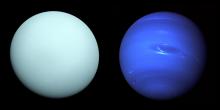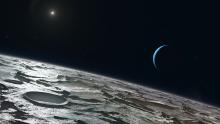Listen to today's episode of StarDate on the web the same day it airs in high-quality streaming audio without any extra ads or announcements. Choose a $8 one-month pass, or listen every day for a year for just $30.
You are here
Mars and Neptune
Neptune is a forgotten giant. It’s the fourth-largest planet in the solar system — almost four times the diameter of Earth. Yet it’s so far away that we need help to see it. Out of sight, out of mind.
For the next few nights, though, you can get a good idea of where Neptune is by following a bright point of light — the planet Mars. The Red Planet is well up in the south at nightfall, and looks like a bright orange star.
Tonight, Neptune is about a degree to the upper left of Mars — less than the width of a finger held at arm’s length. Mars will move much closer to Neptune tomorrow night, then slide just past it by Thursday night.
Under dark skies, Neptune is just visible through strong binoculars. But for the best view you need a telescope. The planet looks like a small, faint star, with a hint of blue.
Mars passes by Neptune every couple of years or so. It takes Mars that long to make a full loop against the background of stars.
Neptune doesn’t move nearly that quickly, though. That’s because its average distance from the Sun is about 2.8 billion miles — roughly 20 times farther than Mars is. At that range, it takes 165 years for Neptune to complete one turn through the sky.
Again, look for Mars in the south as the sky gets good and dark, and sliding down the southwestern sky later on. And if you have dark skies and some help, take a look for Neptune, too — a forgotten giant near the Red Planet.
Script by Damond Benningfield





